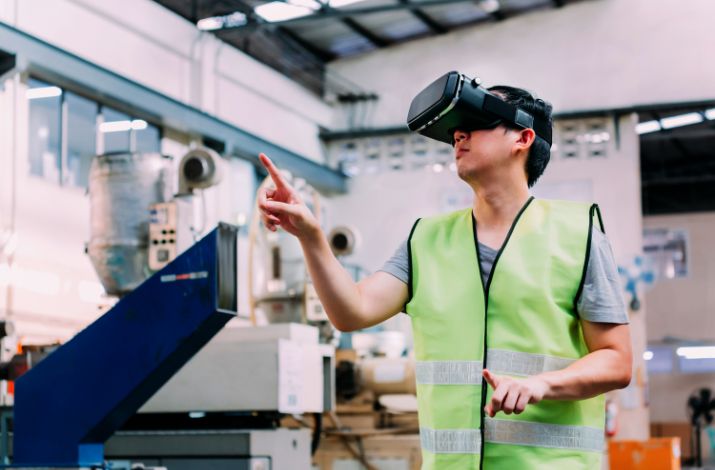Virtual Reality for Manufacturing: Use Cases and Benefits

Virtual reality technology is already transforming how manufacturers work, but working with VR technology at scale remains difficult. When you think of virtual reality, you probably don’t immediately imagine manufacturing, but the manufacturing sector is one area where VR is demonstrated to be particularly valuable. Multiple large manufacturers have already utilized this incredible tool despite its initial challenges.
This blog post will explore the use cases and benefits of incorporating virtual reality into manufacturing processes that highlight how it can improve efficiency, reduce costs, and increase safety.
What is Virtual Reality for Manufacturing?
Virtual Reality (VR) represents an interactive simulation technique that empowers manufacturers to forge an immersive realm for evaluating and fabricating three-dimensional models. Through VR, manufacturers can forge virtual prototypes and simulations of their products, facilitating the exploration of various attributes and scenarios to ascertain optimal production methods. Leveraging VR technology, manufacturers can seamlessly present an entire product or its minutest constituents to showcase its functionality. This versatile technology finds applications in crafting prototypes for machinery, tools, equipment, or systems, product testing, and employee training endeavors.
Use Cases of Virtual Reality for Manufacturing:
Recognizing the significance of virtual technology in maintaining competitiveness within the manufacturing marketplace, several instances highlight how certain companies use VR to transform their manufacturing and related procedures. These examples underscore the tangible use cases of these technologies are already yielding:
Inventory Management
The logistics firm DHL was one of the pioneers in integrating Virtual Reality (VR) into its inventory management system. Collaborating with their customer Ricoh and wearable technology specialist Ubimax, DHL introduced a “vision picking” pilot program in their warehouse operations. Using intelligent glasses and VR technology, graphical cues were projected onto the smart glasses to assist workers in navigating the warehouse. This resulted in a reduction of errors and a faster picking process.
Vehicle Design and Build
Virtual Reality (VR) is progressively becoming a standard practice at the forefront of the automotive sector. In addition to longstanding adopters like Ford, which integrated virtual technology as early as 1999, Hyundai has embraced VR and 3D digital instruments for crafting novel vehicles and components. VR empowers designers to assess models within precise contexts that replicate real-world situations, a capability previously unattainable with traditional clay prototypes.
Factory Floor Planning
Virtual technology finds applications in factory floor planning, construction, and manufacturing trade events. In mass-production manufacturing, meticulous factory planning encompassing the strategic arrangement of tools, equipment, and personnel is paramount for optimizing productivity and efficiency. Using virtual environments, plants can be sketched out to assess production workflows and the interactions between human workers and robotic counterparts, all before initiating any alterations in the physical realm.
Complex Assemblies
The application of virtual reality solutions offers the capability to replicate assembly scenarios and train workers that ensure the effective assembly of products. Augmented reality enhances this by overlaying work instructions or pertinent information through VR glasses (smart glasses), facilitating a more understandable and successful assembly process for workers. Virtual reality (VR) technologies suite can facilitate remote collaboration on assembly tasks, enabling experts to offer guidance and support to workers in different locations.

Business Events or Exhibitions
Heavy equipment manufacturers showcasing their products at trade shows and exhibitions often encounter challenges when arranging their displays at the event venue. This task is complex and multifaceted in nature but is now accessible due to Virtual reality (VR). Manufacturers must consider various aspects, like the transportation, installation, and utilization of the machinery during the exhibition. Heavy machinery is typically produced in response to specific requests and is not readily available for display.
Benefits of Virtual Reality for Manufacturing:
Manufacturing enterprises can enhance their operations by shifting complex and high-risk procedures to virtual reality (VR), potentially reducing costs. Tasks like testing, training, and maintenance are often intricate to organize, as they tend to carry both safety risks for workers and the potential to disrupt the manufacturing flow. Given that a significant portion of the machinery utilized in production poses hazards and demands specialized training, VR can effectively address these challenges:
Safety and Risk Reduction
Safety is an utmost priority within the manufacturing sector, and virtual reality (VR) emerges as a tool to alleviate risks by replicating potentially dangerous scenarios without exposing employees to harm. Manufacturers can enhance overall safety measures and diminish the likelihood of accidents by instructing workers to respond to emergencies and adhere to safety protocols within a virtual realm. Virtual simulations aid in identifying potential hazards within the manufacturing setting, facilitating the adoption of proactive measures.
Enhanced Quality Control
Quality control is paramount in manufacturing, and integrating VR technology can profoundly enhance this facet. Through virtual inspections, teams can meticulously assess products and components, preemptively detecting potential concerns before they escalate into expensive errors. This procedure expedites issue resolution and minimizes operational downtime, as refinements can be executed within the virtual sphere before implementation in the tangible world.
Remote Monitoring and Inspection
VR technology facilitates the distant oversight of manufacturing operations and machinery, which allows instantaneous data analysis and maintenance assistance. This technology eliminates the necessity of physically dispatching an inspector to the machine. Instead, it expedites the transmission of the machine’s virtual representation to the inspector’s location. Through creating a VR video depicting the apparatus, manufacturers can remotely inspect the equipment sans the requirement of engaging an on-site expert.
Read Also: The Impact of Emerging Technologies on Accounting and Finance
Advanced Training Opportunities
Virtual Reality (VR) offers the opportunity to immerse new employees in training scenarios closely mirroring actual work processes, facilitating skill development prior to their transition to the production floor. Through immersive training, experts in the field can effortlessly generate detailed, heightened comprehension and shorter training durations, real-time digital instructions superimposed onto real-world equipment. This invariably leads to heightened efficiency in training procedures and contributes to the reduction of training expenses.
Improved Collaboration
Virtual Reality (VR) emerges as a potent solution to tackle the complexities posed by remote work setups effectively. It facilitates seamless and productive real-time collaboration among manufacturing experts, irrespective of their geographical dispersion. These solutions empower teams to share their expertise within virtual realms, swiftly seeking guidance in the event of manufacturing line disruptions. Further, these virtual arenas significantly curtail travel expenses and time while fostering global collaboration among teams in diverse locations.
Final Thoughts
The fusion of virtual reality (VR) and manufacturing heralds a remarkable transformation in the industry’s landscape. Despite initial challenges, VR proves to be a potent tool with diverse applications and tangible benefits. VR’s impact spans inventory management, design, assembly, training, and quality control, from enhancing efficiency and reducing costs to improving safety and enabling remote collaboration. As VR reshapes traditional manufacturing practices, its capacity to simulate, innovate, and optimize holds the potential to usher in a new era of productivity and innovation.


